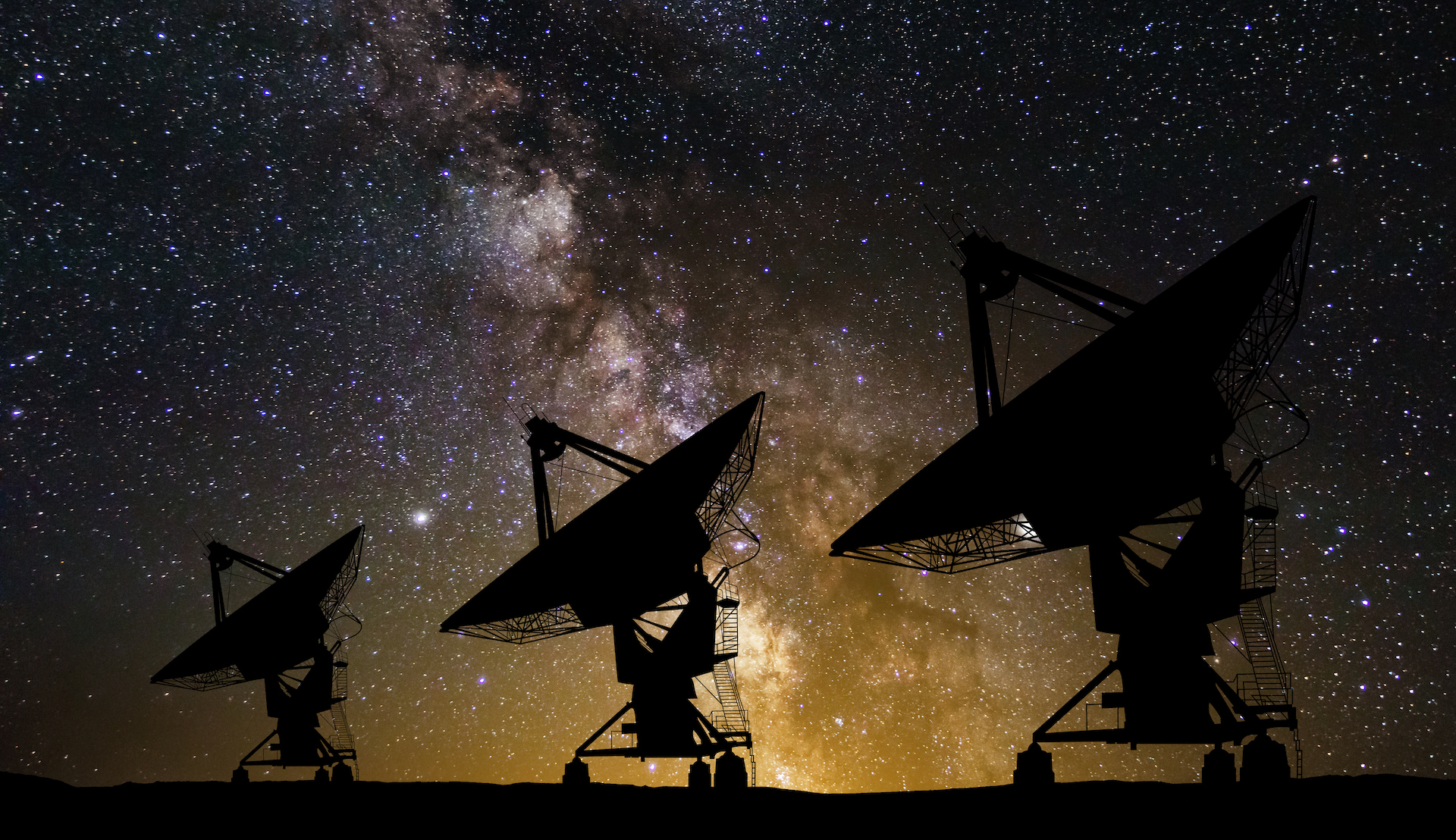Reply From Aliens? Astronomers Anticipate Extraterrestrial Contact For A Message Sent 40 Years Back
Japan Aerospace Exploration Agency scans the sky for a reply from aliens for a message which was sent 40 years back, potentially proving life beyond Earth.

Reply From Aliens? Astronomers Anticipate Extraterrestrial Contact For A Message Sent 40 Years Back
In an unfolding cosmic drama that plays out over decades, across light-years, and sparks the human imagination, astronomers around the globe seem to be on the cusp of a potential breakthrough: contact with extra-terrestrial intelligence. All eyes are turned skyward as the clock ticks down to a crucial moment – the long-anticipated response to a series of radio signals sent into the cosmic abyss about four decades ago.
A Cosmic Call: “Hello, is anybody there?“
On August 15, 1983, two pioneers in the domain of search for extra-terrestrial intelligence (SETI), Professors Masaki Morimoto as well as Hisashi Hirabayashi, got started on an uncertain mission. The duo released a message into the universe from within the hallowed halls of Stanford University in the United States. The message, however, had been encoded in an assortment of thirteen finely produced pictures rather than spoken word or written text. These detailed paintings told the tale of the evolution of humanity and how humans came to live on Earth in a visual narrative.
Drawings showed the evolution of people from microscopic animals that finally migrated from the ocean to the land. It also defined DNA as well as our solar system. If intelligent life existed on nearby planets, it was thought that it would decipher the messages that were sent and, possibly, respond. Asahi Shimbun in her report talking about the same, mentioned that on August 15, 1983, Professors Masaki Morimoto and Hisashi Hirabayashi utilized the antenna at Stanford University to transmit a sequence of radio signals that included 13 graphics that depicted the history of the planet Earth and the appearance of humanity.

A Multidimensional Quest: Seeking Intelligent Life
Their intended audience? Altair, a star in the constellation Aquila, approximately 16.7 light-years away and may host extraterrestrial life. Any intelligent civilisation that might be close to Altair might be able to decode these cosmic drawings and deliver an answer that would reveal the existence of life outside of our solar system. By promoting communication through the common language of creativity and inquisitiveness, this grand gesture sought to span the vast gap between worlds.
New Horizons: Awaiting a Cosmic Response
Fast forward to the present day, when the cosmic stage has been prepared for a momentous occurrence. Shinya Narusawa, a renowned researcher at the University of Hyogo, heads a committed team waiting for action. Their collective focus continues to be focused on Altair, thanks to a massive 64-meter-wide antenna positioned in Saku, Nagano Prefecture. Owing to the rising database of exoplanets identified during the 1990s, this celestial challenger, which is the 12th brightest star in the night sky, is currently considered to be a top possibility for containing life from other dimensions.
On August 22, around 10 p.m., the astronomers anticipate hearing from someone. An hour will be spent by the Japan Aerospace Exploration Agency (JAXA) antenna in Saku, central Japan, searching the skies for a response. The 58-year-old Mr. Narusawa asserted that life with intelligence should exist elsewhere in the cosmos. He said to the Japanese publication, since the 1990s, several exoplanets have been discovered. He added that there might be a planet in Altair with a suitable atmosphere for life.
Astronomical Vigilance: Ears to the Cosmos
A day with cosmic significance has approached: August 22. This day coincides with Tanabata, a “star festival” observed in Japan on the seventh day of the seventh lunar month. Researchers associated with JAXA are going to be on high alert as celebrations commemorate the union of celestial beings. Their antenna will be pointed at the starry sky, ready to pick up any signal that reaches them which could represent a response to the message which was sent in the distant past.

Landmark hearing on UFO sightings in USA
All this is happening one month subsequent to a momentous hearing conducted by US lawmakers, which was centered around the topic of UFO sightings. David Grusch, a former intelligence officer, had stepped forward making bold assertions, contending that the American government is in possession of both intact as well as partially intact alien vehicles.
This revelation follows closely related to a gathering of the House of Representatives, which organised a panel to deliberate on Unidentified Aerial Phenomena (UAPs), more popularly called as UFOs. This meeting represented as important stride towards recognizing the necessity of subjecting these enigmatic incidents to thorough scrutiny at the loftiest tiers of government. Even while Republican Tim Burchett was eager to point out that the objective of the hearing was not in order to conjure up images of “little green men” or flying saucers, but instead to conduct a factual investigation, the testimonies did occasionally drift into the area of speculative guesswork.
Three witnesses related their encounters with items with seemingly impossible physical characteristics during the course of a two-hour session. They described stories of pilots who were hesitant about disclosing their experiences, discussed the recovery of biological material from such vessels, and even alluded to purported cases of retaliation against persons who revealed sensitive information.
In particular, all witnesses acknowledged the possible national security implications of UAPs. While the hearing did not provide ground-breaking insights or definitive confirmation of the presence of extraterrestrial life, its relevance lies in the attention it received. The presence of witnesses before Congress emphasized the seriousness of the situation. Both politicians as well as witnesses used the panel to urge for increased transparency from the military about UAPs.
In simple terms, this latest turn of events adds a layer of complication to the continuing debate over UFOs as well as UAPs. The combination of credible testimonials, plausible security concerns, along with the demand for increased transparency from government establishments heightens the allure of these phenomena. The stage seemed to be set for a long journey of investigation and inquiry into the mysteries hidden within the celestial realm.

A Vast Universe Awaits Discovery
Following the spectacular congressional hearing on unidentified anomalous occurrences and Harvard professor Avi Loeb’s investigation into enigmatic meteorites discovered at the bottom of the ocean, the existence of extraterrestrial life has seldom been left out of the news in the past couple of months. While some are searching for evidence of aliens on our own planet, teams all across the globe are gazing to the skies for the smallest traces of life out there. It may even be present in our very own solar system. The ESA’s Juice mission and NASA‘s Europa Clipper have both been traveling to Jupiter’s icy moons to look for signs of life. They are scheduled to make their appearance in 2030.
Furthermore, the icy moon Enceladus of Saturn was recently discovered to have all of the components required for life in its subterranean waters. The prospect of extraterrestrial life remains a fascinating riddle as humanity continues to unravel the enigmatic secrets of the cosmos. Recent disclosures of unidentified anomalous phenomena as well as groundbreaking research, such as Harvard professor Avi Loeb’s inquiry into marine meteorites, have thrown light on the possibility of extraterrestrial life. However, astronomers are diligently exploring the stars for any sign of life in addition to our blue planet’s boundaries.
The idea of receiving a response from alien creatures in response to the radio signals sent into space forty years ago has major consequences and throws up exciting possibilities for the future of the planet. Astronomers are eagerly awaiting any potential proof of extraterrestrial life, and their excitement is obvious.
Sending a message into the universe with 13 paintings that portray Earth’s history and humanity’s appearance is a sign of mankind’s fascination with and desire to make discoveries about extraterrestrial life. The research conducted in 1983 by Masaki Morimoto and Hisashi Hirabayashi, as well as the ongoing project run by Shinya Narusawa’s team at the University of Hyogo, highlight the continued search for contact with potential extraterrestrial civilizations.
The repercussions would be extensive if a reply were to come from the star Altair, which is 16.7 light years away. Such an occurrence could be a turning point in human history, bringing about a paradigm change in how we view the place that humanity occupies in the cosmos. The discovery of intelligent beings elsewhere may alter philosophical, scientific, as well as cultural narratives, causing us to reflect on our own existence and opening up novel opportunities for research and cooperation.
This possible response’s timing, which falls on Japan’s Tanabata or “star festival,” gives the occasion a symbolic as well as significant quality. In Japanese legend, Tanabata commemorates the union of a pair of star-crossed lovers and offers a captivating setting for speaking with an unidentified heavenly being.
This development also highlights how far technology has come, as the antenna of the Japan Aerospace Exploration Agency in Saku monitors the skies for a response. The prospect for deeper links with hypothetical alien civilizations is made possible by our improved capacity for communication across huge cosmic dimensions. The possible existence of life with intelligence existing somewhere other than Earth is suggested by the large number of exoplanets discovered, according to Mr. Narusawa’s theory, which heightens the excitement for the occasion. If Altair responds, it may shed light on the circumstances required for the emergence and maintenance of life, affecting our comprehension of habitable environments.
Finally, the potential of receiving a response from aliens in response to the radio signals delivered decades ago has consequences that transcend beyond simply curiosity about science. It invites us to rethink our place in the cosmos, challenges our ideas about the distinctiveness of life, as well as highlights the possibility of interplanetary contact and collaboration. Whatever the conclusion, the journey of searching for extraterrestrial contact exemplifies humanity’s enduring curiosity and resolve to find answers to the cosmos’ mysteries.
In this massive cosmic symphony, where planets move and stars shimmer, the search for intelligent life is a quest for connection and communication – a reaching out across the enormous expanses of space as well as time. The imminent hour approaches, as the world watches and waits with anxious anticipation. Could today be the day when humanity finally obtains an extra-terrestrial reply, transported through the vacuum of space and falling into our eager ears? As the tale unfolds, it reminds us that the human beings’ urge to connect is not limited to our own kind but transcends to the very stars themselves.





